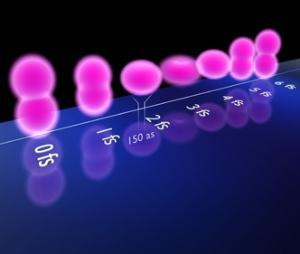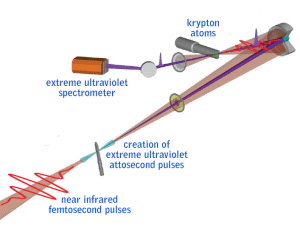


An international team from the Laboratory for Attosecond Physics (www.attoworld.de), led by Prof. Ferenc Krausz at the Max Planck Institute of Quantum Optics and the Ludwig-Maximilians-Universität in Munich, in collaborations with researchers from the United States and Saudi Arabia, have observed, for the first time, the quantum-mechanical behaviour occurring at the location in a noble gas atom where, shortly before, an electron had been ejected from its orbit.
The researchers achieved this result using light pulses which last only slightly longer than 100 attoseconds.
Quantum particles, such as electrons, are volatile entities, governed by the laws of quantum mechanics. Movements of electrons in their atomic orbitals last for just a few attoseconds. One attosecond is one billionth of one billionth of a second. What exactly the elementary particles do in the atoms" atmosphere is, currently, largely unknown. It is, however, clearly understood that one cannot determine both the momentum and location of a particle at the same time. Consequently, the quantum mechanical motion of these elementary particles can be described in terms of a cloud called the "probability density of the particles" subject to rapid pulsation following an excitation.
Now, for the first time, the international team from the Laboratory for Attosecond Physics (LAP) have succeeded in observing how an electron cloud moves with time when one of the electrons in an atom is ejected by a pulse of light. The research collaboration included physicists from the Max Planck Institute of Quantum Optics at Garching, the Ludwig-Maximilians-Universität in Munich, the King Saud University in Riyadh (Saudi Arabia), the Argonne National Laboratory (U.S.) and the University of California, Berkeley (U.S.).
In their experiments, the physicists allowed laser pulses in the visible range of the spectrum to encounter krypton atoms. The light pulses, with a duration of less than four femtoseconds, in each case ejected an electron from the outer shells of the atoms (a femtosecond is one millionth of one billionth of a second).
Once a laser pulse has knocked an electron out of an atom, the atom becomes a positively charged ion. At the point where the electron has left the atom, a positively charged hole develops inside the ion. Quantum mechanically, this free space then continues to pulsate inside the atom as a so-called quantum beat.
The physicists could now directly observe, and virtually photograph, this pulsation using a second ultraviolet light pulse, lasting only some 150 attoseconds. It turned out that the position of the hole inside the ion, i.e., the positively charged location, moved back and forth between an elongated, club-like shape and a compact, contracted shape, with a cycle period of only around 6 femtoseconds. "Thus, for the first time ever, we succeeded in directly observing the change occurring in the charge distribution inside an atom," explains Dr. Eleftherios Goulielmakis, research group leader in the team of Prof. Krausz.
"Our experiments have given us a unique real-time view of the micro-cosmos," explains Ferenc Krausz. "Using attosecond light flashes, we have for the first time recorded quantum- mechanical processes inside an ionised atom." The findings of the LAP researchers help one to understand the dynamics of elementary particles outside of the atomic nucleus. In more complex (molecular) systems this kind of split-second dynamics is primarily responsible for the sequence of biological and chemical processes. A more precise understanding of this dynamics could in the future lead to a better understanding of the microscopic origin of currently incurable diseases, or to a gradual acceleration in the speed of electronic data processing towards the ultimate limit of electronics [Thorsten Naeser].
Berkeley Lab news release:
For the First Time Ever, Scientists Watch an Atom's Electrons Moving in Real Time
An international team of scientists led by groups from the Max Planck Institute of Quantum Optics (MPQ) in Garching, Germany, and from the U.S. Department of Energy"s Lawrence Berkeley National Laboratory and the University of California at Berkeley has used ultrashort flashes of laser light to directly observe the movement of an atom"s outer electrons for the first time.
Through a process called attosecond absorption spectroscopy, researchers were able to time the oscillations between simultaneously produced quantum states of valence electrons with great precision. These oscillations drive electron motion.
"With a simple system of krypton atoms, we demonstrated, for the first time, that we can measure transient absorption dynamics with attosecond pulses," says Stephen Leone of Berkeley Lab"s Chemical Sciences Division, who is also a professor of chemistry and physics at UC Berkeley. "This revealed details of a type of electronic motion - coherent superposition - that can control properties in many systems."
Leone cites recent work by the Graham Fleming group at Berkeley on the crucial role of coherent dynamics in photosynthesis as an example of its importance, noting that "the method developed by our team for exploring coherent dynamics has never before been available to researchers. It's truly general and can be applied to attosecond electronic dynamics problems in the physics and chemistry of liquids, solids, biological systems, everything."
The team's demonstration of attosecond absorption spectroscopy began by first ionizing krypton atoms, removing one or more outer valence electrons with pulses of near-infrared laser light that were typically measured on timescales of a few femtoseconds (a femtosecond is 10-15 second, a quadrillionth of a second). Then, with far shorter pulses of extreme ultraviolet light on the 100-attosecond timescale (an attosecond is 10-18 second, a quintillionth of a second), they were able to precisely measure the effects on the valence electron orbitals.
The results of the pioneering measurements performed at MPQ by the Leone and Krausz groups and their colleagues are reported in the August 5 issue of the journal Nature.
Parsing the fine points of valence electron motion
Valence electrons control how atoms bond with other atoms to form molecules or crystal structures, and how these bonds break and reform during chemical reactions. Changes in molecular structures occur on the scale of many femtoseconds and have often been observed with femtosecond spectroscopy, in which both Leone and Krausz are pioneers.
Zhi-Heng Loh of Leone's group at Berkeley Lab and UC Berkeley worked with Eleftherios Goulielmakis of Krausz"s group to perform the experiments at MPQ. By firing a femtosecond pulse of infrared laser light through a chamber filled with krypton gas, atoms in the path of the beam were ionized by the loss of from one to three valence electrons from their outermost shells.
The experimenters separately generated extreme-ultraviolet attosecond pulses (using the technique called "high harmonic generation") and sent the beam of attosecond probe pulses through the krypton gas on the same path as the near-infrared pump pulses.
By varying the time delay between the pump pulse and the probe pulse, the researchers found that subsequent states of increasing ionization were being produced at regular intervals, which turned out to be approximately equal to the time for a half cycle of the pump pulse. (The pulse is only a few cycles long; the time from crest to crest is a full cycle, and from crest to trough is a half cycle.)
"The femtosecond pulse produces a strong electromagnetic field, and ionization takes place with every half cycle of the pulse," Leone says. "Therefore little bursts of ions are coming out every half cycle."
Although expected from theory, these isolated bursts were not resolved in the experiment. The attosecond pulses, however, could precisely measure the production of the ionization, because ionization - the removal of one or more electrons - leaves gaps or "holes," unfilled orbitals that the ultrashort pulses can probe.
The attosecond pulses do so by exciting electrons from lower energy orbitals to fill the gap in krypton"s outermost orbital - a direct result of the absorption of the transient attosecond pulses by the atoms. After the "long" femtosecond pump pulse liberates an electron from outermost orbital (designated 4p), the short probe pulse boosts an electron from an inner orbital (designated 3d), leaving behind a hole in that orbital while sensing the dynamics of the outermost orbital.
In singly charged krypton ions, two electronic states are formed. A wave-packet of electronic motion is observed between these two states, indicating that the ionization process forms the two states in what"s known as quantum coherence.
Says Leone, "There is a continual ‘orbital flopping" between the two states, which interfere with each other. A high degree of interference is called coherence." Thus when the attosecond probe pulse clocks the outer valence orbitals, it is really clocking the high degree of coherence in the orbital motion caused by ionization.
Indispensable attosecond pulses
"When the bursts of ions are made quickly enough, with just a few cycles of the ionization pulse, we observe a high degree of coherence," Leone says. "Theoretically, however, with longer ionization pulses the production of the ions gets out of phase with the period of the electron wave-packet motion, as our work showed."
So after just a few cycles of the pump pulse, the coherence is washed out. Thus, says Leone, "Without very short, attosecond-scale probe pulses, we could not have measured the degree of coherence that resulted from ionization."
The physical demonstration of attosecond transient absorption by the combined efforts of the Leone and Krausz groups and their colleagues will, in Leone"s words, "allow us to unravel processes within and among atoms, molecules, and crystals on the electronic timescale" - processes that previously could only be hinted at with studies on the comparatively languorous femtosecond timescale.
"Real-time observation of valence electron motion," by Eleftherios Goulielmakis, Zhi-Heng Loh, Adrian Wirth, Robin Santra, Nina Rohringer, Vladislav Yakovlev, Sergey Zherebtsov, Thomas Pfeifer, Abdallah Azzeer, Matthias Kling, Stephen Leone, and Ferenc Krausz, appears in the 5 August 2010 issue of the journal Nature. This work was supported by the Max Planck Society, King Saud University, and the Munich Center for Advanced Photonics. Stephen Leone"s group is supported by the Air Force Office of Scientific Research, the National Science Foundation, and U.S. Department of Energy"s Office of Science. Theoretical modeling was led by Robin Santra, who is supported by DOE"s Office of Science.
Lawrence Berkeley National Laboratory provides solutions to the world's most urgent scientific challenges including clean energy, climate change, human health, novel materials, and a better understanding of matter and force in the universe. It is a world leader in improving our lives and knowledge of the world around us through innovative science, advanced computing, and technology that makes a difference. Berkeley Lab is a U.S. Department of Energy (DOE) national laboratory managed by the University of California for the DOE Office of Science.
Further Information:
Eleftherios Goulielmakis, Zhi-Heng Loh, Adrian Wirth, Robin Santra, Nina Rohringer, Vladislav S. Yakovlev, Sergey Zherebtsov, Thomas Pfeifer, Abdallah M. Azzeer, Matthias F. Kling, Stephen R. Leone, Ferenc Krausz:
Real-time observation of valence electron motion.
In: Nature; 466, 739-743, 5 August 2010, DOI 10.1038/nature09212
Source: Max Planck Institute of Quantum Optics, MPQ, Garching, Germany
Last update: 05.08.2010
Perma link: https://www.internetchemistry.com/news/2010/aug10/observation-of-valence-electron-motion.php
More chemistry: index | chemicals | lab equipment | job vacancies | sitemap
Internetchemistry: home | about | contact | imprint | privacy
© 1996 - 2023 Internetchemistry
